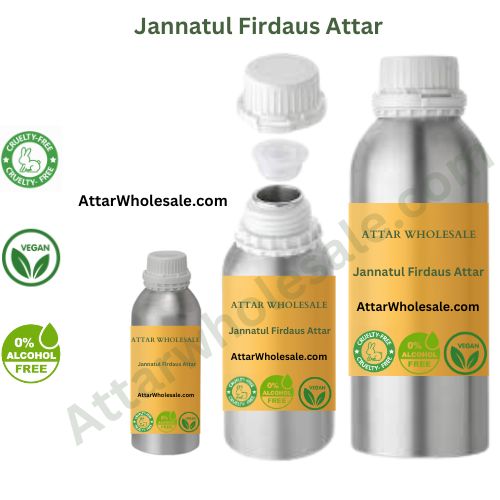Jannatul Firdous Attar – A Heavenly Fragrance Inspired by Paradise
Jannatul Firdous Attar – A Heavenly Fragrance Inspired by Paradise
Couldn't load pickup availability
Premium Wholesale Perfume Oil by Attar Wholesale
Step into the garden of serenity with Jannatul Firdous Attar, a divine, classic fragrance rooted in the traditions of the East and celebrated across generations. Translated as "Garden of Paradise," Jannatul Firdous is a mystical blend of florals, herbs, and musky undertones that evoke peace, purity, and spiritual depth. Carefully crafted by Attar Wholesale, this traditional perfume oil offers a timeless aroma that is both grounding and uplifting.
Now available in jannatul firdous attar wholesale, this evergreen scent is perfect for bulk buyers, fragrance resellers, prayer supply shops, and businesses seeking high-quality perfume oils at competitive prices.
🌸 Fragrance Profile:
-
Top Notes: Fresh green herbs and soft florals greet the senses with a burst of brightness.
-
Middle Notes: Heart notes of rose, jasmine, and subtle spices bring warmth and complexity.
-
Base Notes: Earthy musk and woody undertones leave a soothing and long-lasting trail, perfect for spiritual and daily use.
💎 Why Choose Jannatul Firdous Perfume Oil from Attar Wholesale?
✅ 100% Natural & Alcohol-Free
Made using traditional distillation techniques, our jannatul firdous attar is free from alcohol and harsh chemicals, making it ideal for personal use, meditation, and prayer.
✅ Long-Lasting Fragrance
Oil-based and highly concentrated, this attar clings gently to the skin, evolving gracefully and lasting throughout the day.
✅ Ideal for All Genders & Ages
Universally loved and unisex, this classic fragrance suits men, women, and even younger users for its soft, spiritual appeal.
✅ Jannatul Firdous Perfume Oil Wholesale Pricing
We supply jannatul firdous perfume oil wholesale in bulk volumes for retailers, distributors, and resellers worldwide. Get authentic, high-quality attar at factory-direct prices.
✅ Custom & Bulk Packaging Options
From elegant 3ml bottles to large-scale packaging for private labels, we offer flexible options tailored to your business needs.
🕌 A Fragrance with Spiritual Depth
Loved in Islamic and South Asian cultures for generations, Jannatul Firdous Attar is often used during prayers, Ramadan, Eid, and other spiritual gatherings. Its calming yet inspiring scent connects the wearer to an inner state of peace, reflection, and purity—making it more than just a fragrance, but a spiritual companion.
📦 Perfect For:
-
Retailers looking for jannatul firdous attar wholesale
-
Prayer supply stores and Islamic shops
-
Online sellers of natural attars and spiritual oils
-
Individuals seeking natural, non-alcoholic fragrance for daily use
-
Private label brands in search of heritage-inspired perfume oils
✨ Bring Paradise Closer
Let the divine aroma of Jannatul Firdous transport you to an eternal garden of peace and purity. At Attar Wholesale, we are proud to deliver this sacred fragrance in its most authentic form, available for bulk orders with worldwide shipping.
Order Your Jannatul Firdous Attar at Wholesale Rates Now
✔ Trusted quality from Attar Wholesale
✔ Custom labeling & white-labeling options
✔ Fast dispatch & global delivery support
About Jannatul Firdaus Attar:
Known for its musky, wild rich and long lasting fragrance, Jannatul Firdaus is a heavely attar with a floral fresh fragrance top in top note which twists in to a bloom of spices and finally settles warmly with base of ruh khus or vetiver.
The name “Jannat ul firdaus” is derived from the Arabic word meaning ‘Highest Paradise’. This attar is also among top-selling attar in category of arabic scents and natural blends experiences.
Buy Jannatul Firdaus Attar, Scent , Perfume Oil, Itra Online from Attar Wholesale.
How does “Jannatul Firdaus Attar” Smells Like?
Jannatul Firdaus is unique rich aroma as it constitutes Jasmine, blue lotus, rose, gardenia, woody and herbal notes.
Jannatul Firdaus Attar is a type of whole wheat flour known for its high quality and superior taste. It is popularly used in South Asian cuisine, particularly in regions like Bangladesh, India, and Pakistan. The name "Jannatul Firdaus" translates to "Garden of Paradise" in Arabic, indicating the exceptional quality and flavor associated with this flour.
A bold and vibrant attar featuring green herbal top notes, a spicy floral heart, and a woody amber base. Long-lasting and distinctly recognizable.
🌿 100% Natural & Alcohol-Free Attar
🌸 Signature fragrance with green, spicy, floral, and woody notes
🕌 Popular in Islamic, Arabic, and Indian perfumery traditions
👨👩 Suitable for both men and women (Unisex)
🕌 Ideal for prayer, daily wear, meditation, or gifting
🧴 Available in 10ml to 1L bulk packaging
🏷️ OEM / Private Labeling Options for resellers
🚚 Worldwide shipping with bulk order discounts
MOQ: 50ml (for samples) | Bulk available from 500ml+
Processing Time: 2–5 business days depending on quantity
Applications:
Daily personal fragrance
Gift sets and Islamic prayer kits
Retail and reselling (perfume shops, online stores)
Aromatherapy or traditional uses
Overall, Jannatul Firdaus Attar is prized for its nutritional benefits, superior taste, and cultural significance, making it a staple ingredient in South Asian households and an essential part of traditional cuisine.Buy Jannatul Firdaus Attar Wholesale.






